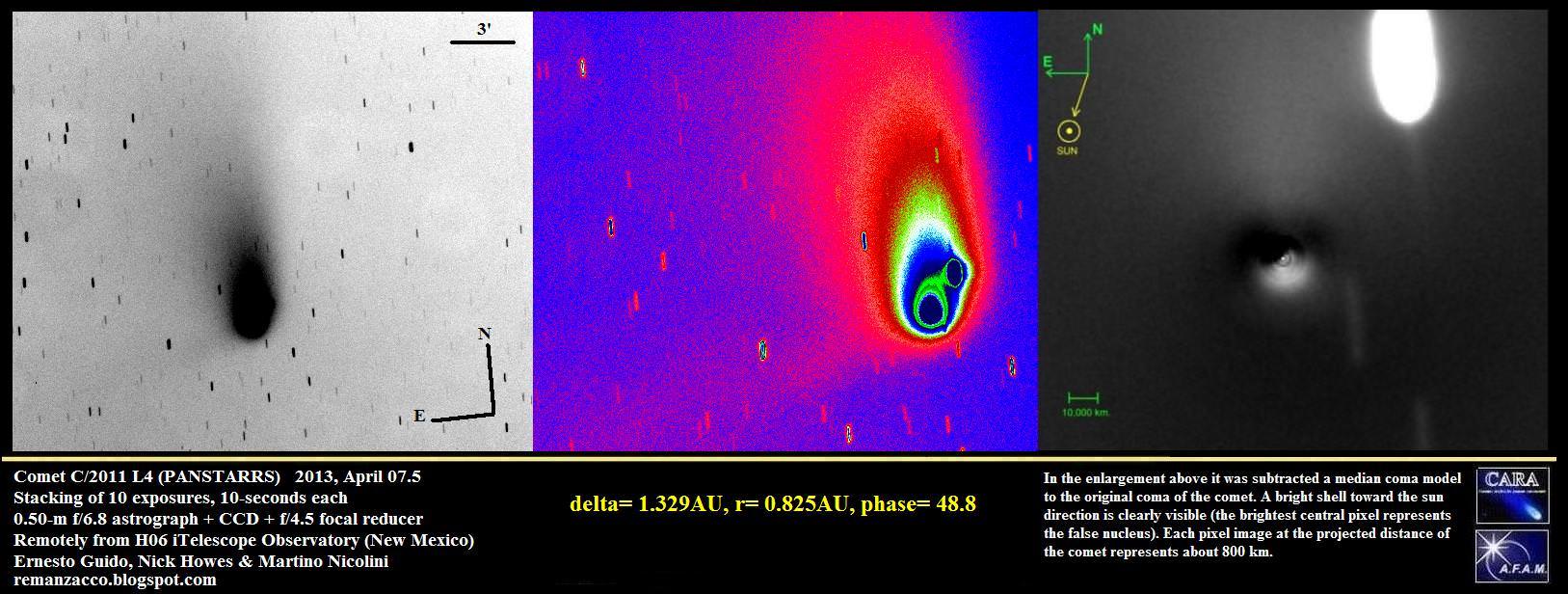Comet PANSTARRS has peaked, but astronomers are still keeping an eye on this comet to try and determine what its future might hold. The team from the Remanzacco Observatory has just produced some really interesting views of Comet PANSTARRS, with a little help from Martino Nicolini and his Astroart software.
Team member Nick Howes called this software “one of the best astronomical image processing and acquisition tools around,” and explained how these views can tell astronomers more about what is happening with the comet.
“The isophotes image (color coded) is a good way to see the morphology/structure of the coma,” he told Universe Today, adding that comparing the images here is “a very good way to determine any major events like a fragmentation. We’re hopeful that once PANSTARRS gets a bit higher, we’ll be able to look at it in even more detail with the 2 meter Faulkes scopes.”
And with the image processing in the image on the far right, it’s possible to see a bright shell in the coma of comet C/2011 L4 (PANSTARRS).
“The last elaboration in that image has been obtained using the M.C.M. (Median Coma Model), a filter that has the purpose of creating — from an image of a comet — a synthetic model of the ‘regular’ coma,” said Ernesto Guido, from the Remanzacco team. “That is obtained by mapping all the pixels that compose the image and averaging them together. In doing so we delete all the morphological “non-uniformity” contained in the coma itself. This regular coma will then be subtracted from the original image highlighting all the details that are normally immersed in the uniform brightness of the coma.”
Check out the Remanzacco website for more information and their continued updates.


It’s not hard to lasso a comet. It’s hanging on to it once ya gots it lassoed.
The definition of those pics are quite remarkable. R&D, R&D, & R&D is the key! I want to give a big-huge thumbs up to Astroart-Software & the developers for their R&D! Keep it up all! Blessings to you all.
Nice write up Nancy! Astro art is a fine program, and has some very useful tools which are very beneficial to comet and astro imagers alike. As an astroimager myself specializing in comet imaging, Id like to add a few additional points to this update. First, you must be very careful and contentious when processing the dim and subtle details in comets. One can easily over process or bring out non existent features with any software, leading to false conclusions. A good tool is the gradient mapping, or false mapped colors as seen here in the photo in the middle. Since you are doing a global function – essentially remapping brightness information to color information to make it easier to visualize, most of the details revealed by this technique are the real deal.
Another great tool is high pass filtering. Since this is also a global – total image function, it will not bring out artificial features not in the original and can reveal shells of material streaming from the nuclear region, jets of material and disconnection events. It WILL however show any lumps in the noise in the image if done too strongly!
You must be very cautious about filters such as the Larson-Sekanina filter, which as of late has been used in many posted images on “official sites” to show some rather amazing, but unfortunately non existent details. Such filters essentially take a negative of the image rotate it around the nucleus as a rotation point and then layer it back on the image in a composite. For completely symmetrical objects such as a perfectly round comet head this works very well, showing faint structures down inside the coma that may not be visible by any other means. However for comets like Panstarrs, which the head is a large fan shape – doing this yields “details” such as rays in the tail, coma shells and false synchrones that are just not there.
Intelligent use of such filters by the comet imager is mandatory. Overall, there are many tools available to comet imagers today that simply did not exist 30 years ago when I started imaging comets professionally. Back then we stacked negatives, made blurry positive unsharp masks and even manually dodged the core of comets to bring out faint inner details. Oh how its is so different now!
Chris Schur
Sr. Engineer
Birch Mesa Observatory, Az
Thanks for the great info, Chris!
Chris, are they looking into even higher imaging & filtering etc..? Another words, are they continuing to be in the R&D(research & development)phase/stage? I am a R&D man all the way. Common sense dictates R&D should not stop unless the end result has been fully exhausted. Take care.